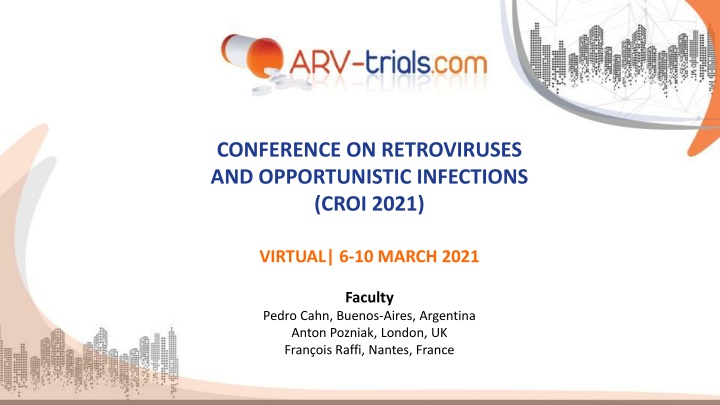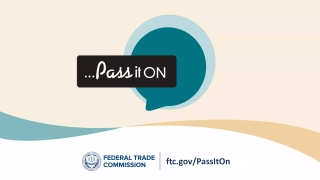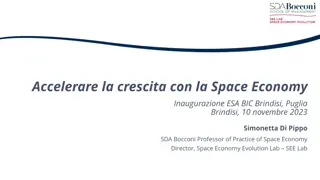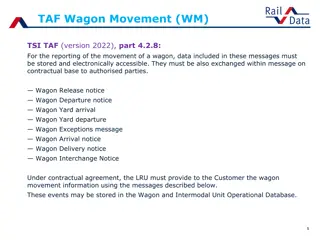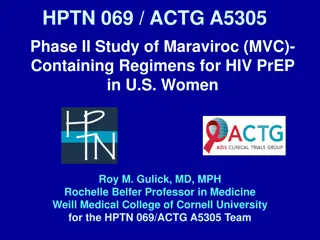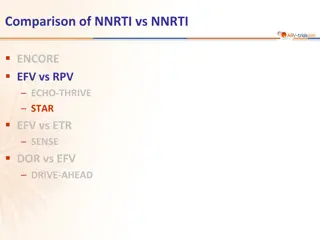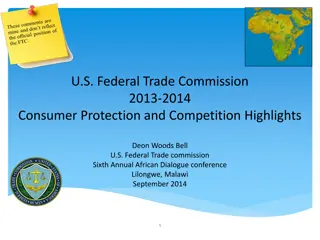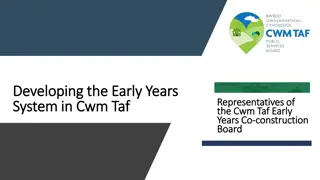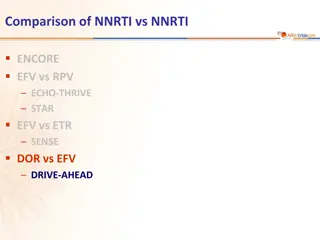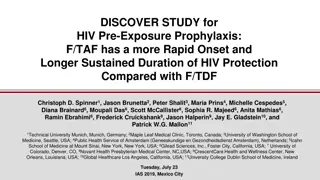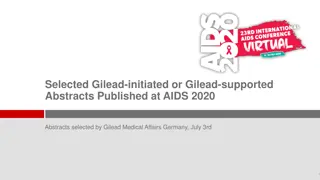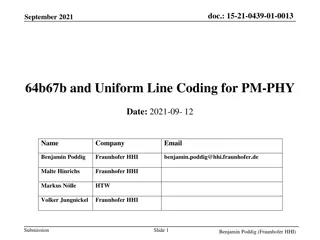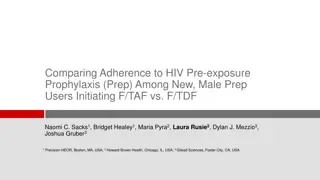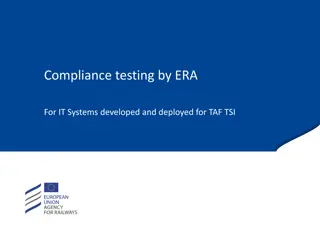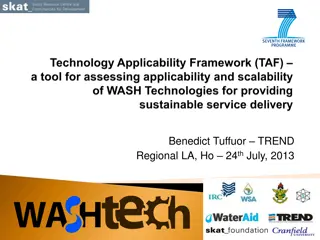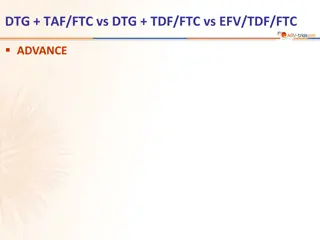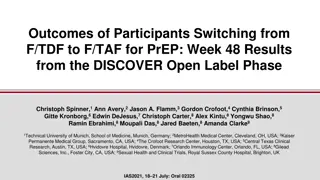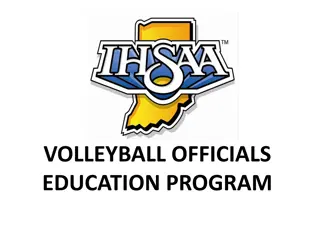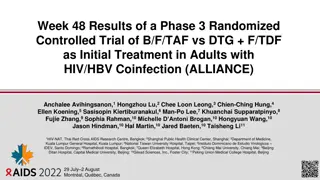BIC/FTC/TAF 4-Year Results in First-line ART
Examining the 4-year results of BIC/FTC/TAF as first-line antiretroviral therapy in treatment-naive adults. The presentation delves into randomized trials, inclusion criteria, and outcomes like viral load suppression. Detailed data on the impact of different ARV strategies, key findings, and implications from the CROI 2021 conference are highlighted. Disclosure of research support and institutional backing adds transparency to the findings presented by esteemed faculty members.
Download Presentation

Please find below an Image/Link to download the presentation.
The content on the website is provided AS IS for your information and personal use only. It may not be sold, licensed, or shared on other websites without obtaining consent from the author.If you encounter any issues during the download, it is possible that the publisher has removed the file from their server.
You are allowed to download the files provided on this website for personal or commercial use, subject to the condition that they are used lawfully. All files are the property of their respective owners.
The content on the website is provided AS IS for your information and personal use only. It may not be sold, licensed, or shared on other websites without obtaining consent from the author.
E N D
Presentation Transcript
CONFERENCE ON RETROVIRUSES AND OPPORTUNISTIC INFECTIONS (CROI 2021) VIRTUAL| 6-10 MARCH 2021 Faculty Pedro Cahn, Buenos-Aires, Argentina Anton Pozniak, London, UK Fran ois Raffi, Nantes, France
This presentation is made in complete editorial freedom Thanks to ViiV Healthcare for their institutional support
Disclosure Pedro Cahn has received research support and/or honoraria for consulting and/or advisory boards from, Merck & Co., Inc. ; ViiV Healthcare, Janssen Anton Pozniak has received research support and/or honoraria for consulting and/or advisory boards from ; Gilead Sciences Medical Affairs ; Merck & Co., Inc. ; ViiV Healthcare, Janssen, Theratechnologies Fran ois Raffi has received research support and/or honoraria for consulting and/or advisory boards from ; Gilead Sciences Medical Affairs ; Merck & Co., Inc. ; ViiV Healthcare, Janssen, Theratechnologies
BIC/FTC/TAF 4y 1489 1490 DTG + 3TC 3y GEMINI Switch to DTG + 3TC Impact of M184V ARV strategies DTG vs DRV/r (+ TDF/3TC vs ZD/3TC) 2ndline NADIA Maintenance 4 days/7 QUATUOR CAB LA + RPV LA Q4W vs Q8W ATLAS-2M
BIC/FTC/TAF as first line ART: results at 4 years (1) 2 randomised multicentric, double-blinded trials 1 endpoint 2 endpoint 2 endpoint 2 endpoint W0 W48 W96 W144 W192 W240 Treatment-Na ve Adults BIC/FTC/TAF qd N=314 Study 1489 HLA B*5701 negative Negative for chronic HBV eGFReCG> 50 mL/min DTG/ABC/3TC placebo qd BIC/FTC/TAF Open-label 1:1 DTG/ABC/3TC qd N=315 BIC/FTC/TAF placebo qd Key inclusion criteria for both: No known resistance to FTC, TAF, ABC or 3TC HIV-1 RNA > 500 c/mL BIC/FTC/TAF qd N=320 Study 1490 Chronic HBV or HCV infection allowed eGFRCG> 30 mL/min DTG + F/TAF placebo qd BIC/FTC/TAF Open-label 1:1 DTG + F/TAF qd N=325 BIC/FTC/TAF placebo qd Workowski K, CROI 2021, Abs. 415
BIC/FTC/TAF as first line ART: results at 4 years (2) pVL < 50 c/mL, ITT snapshot (missing = excluded) BIC/FTC/TAF DTG/ABC/3TC BIC/FTC/TAF DTG + FTC/TAF BIC/FTC/TAF Study 1489 Study 1490 % 100 99.6 % 100 - 100 - 99.7 98.9 99.6 99.2 99.0 100 99.3 99.2 80 - 80 - 60 - 60 - 40 - 40 - 20 - 20 - 0 - 0 - I I I I I I I I I I I I I I I I I 0 24 48 72 96 120 144 168 192 24 48 72 96 120 144 168 192 0 Week Week 314 254 305 241 295 212 280 281 270 261 254 237 320 265 302 258 294 225 284 276 273 270 251 243 Workowski K, CROI 2021, Abs. 415
BIC/FTC/TAF as first line ART: results at 4 years (3) Changes in renal and bone parameters * Median change (IQR) of eGFRCG*mL/min % mean change (95 % CI) of bone mineral density 1489 2 - 2 - 10 - Study 1489 Study 1490 Spine Hip 10 - 1 - 1 - 5 - 5 - 0 - 0 - 0 - 0 - -5 - -5 - -1 - -1 - -0.5 -0.8 -0.7 -0.8 - 5.2 -10 - -10 - -1.1 - 6.9 - 6.1 -1.1 - 7.4 -0.9 - 8.4 -2 - -2 - - 7.6 - 7.7 - 10.2 -1.4 -15 - -15 - I I I I I I I I -3 - -3 - W48 W96 W144 W192 W48 W96 W144 W192 BL BL -20 - -20 - -25 - -25 - 304 284 267 263 178 300 278 261 246 176 I I I I I I I I I I I I I I I I W24 W48 W72 W96 W120 W144 W168 W192 W24 W48 W72 W96 W120 W144 W168 W192 BL BL * Analysis limited to patients initially randomised to BIC/FTC/TAF Workowski K, CROI 2021, Abs. 415
BIC/FTC/TAF as first line ART: results at 4 years (4) Median change in weight, kg (IQR) during double-blind phase Median change of weight, kg (IQR) on BIC/FTC/TAF * BIC/FTC/TAF DTG/ABC/3TC BIC/FTC/TAF DTG + FTC/TAF BIC/FTC/TAF 10 - 10 - 12 - Study 1489 Study 1490 Study 1489 Study 1490 10 - 10 - 8 - 8 - 8 - 8 - 6 - 6 - + 5.0 + 4.4 + 5.0 6 - 6 - + 4.6 +4.3 + 4.1 + 3.5 + 4.0 4 - 4 - + 3.6 + 3.4 + 3.0 + 2.9 4 - 4 - 2 - 2 - 2 - 2 - 0 - 0 - 0 - 0 - -2 - -2 - -2 - -2 - I I I I I I I I I I I I I I I I I I I I I I I I I I I I W24 W48 W72 W96 W120 W144 W168 W192 W24 W48 W72 W96 W120 W144 W168 W192 BL BL W24 W48 W72 W96 W120 W144 W24 W48 W72 W96 W120 W144 BL BL 320 303 293 284 276 273 270 252 247 314 305 295 281 281 270 263 254 238 * Analysis limited to patients initially randomised to BIC/FTC/TAF Workowski K, CROI 2021, Abs. 415
GEMINI-1 et 2 Studies: DTG + 3TC 2DR versus DTG + TDF/FTC as first line ART Results at W144 (1) International, randomised double-blind randomised trials Inclusion criteria Adults HIV+, ARV na ve Plasma HIV RNA between 1000 and 500,000 c/mL, no resistance mutation Non HBV infection, no need for HCV treatment Double-blind Phase Open-label Phase Continuation Phase DTG + 3TC (N = 716) Randomisation 1:1 ART-naive adults VL 1000 500,000 c/mL DTG + 3TC DTG + TDF/FTC (N = 717) Day 1 W48 W96 W144 Primary endpoint % HIV-1 RNA < 50 c/mL at W48 by ITT (snapshot) analysis, missing = failure, with non-inferiority margin of - 10 % for each trial) Non-inferiority achieved at W48 (Cahn P. Lancet 2019;393:143-55) Orkin C. CROI 2021, Abs. 414
GEMINI-1 et 2 Studies: DTG + 3TC 2DR versus DTG + TDF/FTC as first line ART Results at W144 (2) DTG + 3TC is non-inferior to DTG + TDF/FTC at Week 144 DTG + 3TC DTG + TDF/FTC 79 281/356 296/358 GEMINI-1 83 DTG + 3TC DTG + TDF/FTC GEMINI-1 84 303/360 303/359 -9.4 -3.6 2.1 GEMINI-2 84 GEMINI-2 -5.3 0.0 5.3 82 584/716 599/717 Pooled Pooled 84 -5.8 -1.8 2.1 8 6 -10 0 2 4 10 -2 -6 -8 -4 0 20 40 60 80 100 Adjusted difference in proportion (95% CI) HIV-1 RNA < 50 c/mL, % Through W144, 12 participants in the DTG + 3TC group and 9 in the DTG + TDF/FTC group met protocol-defined CVW criteria; there were no treatment-emergent INSTI or NRTI resistance mutations 1 non-CVW participant with reported intermittent non-adherence in the DTG + 3TC group developed M184V at W132 (pVL 61 ,927 c/mL) and R263R/K at W144 (pVL 135 c/mL), conferring a 1.8-fold change in susceptibility to DTG Orkin C. CROI 2021, Abs. 414
GEMINI-1 et 2 Studies: DTG + 3TC 2DR versus DTG + TDF/FTC as first line ART Results at W144 (3) HIV-1 RNA <50 c/mL Comparable Across Baseline Disease Subgroups at W144 DTG + 3TC DTG + TDF/FTC DTG + 3TC DTG + TDF/FTC -1.8 82 Overall 84 82 - 1.5 > 100 000 84 Baseline HIV-1 RNA, c/mL 81 < 100 000 -2.1 84 83 > 200 - 1.1 84 Baseline CDA+ cell count, cells/mm3 67 < 200 76 - 9.7 86 A - 6.3 92 80 HIV subtype B - 1.1 81 84 Other -3.4 87 72 Positive 78 - 5.8 Hepatitis C virus serostatus 82 Negative -1.7 84 0 20 40 60 80 100 30 -30 -20 -10 0 10 20 Participants with HIV-RNA < 50 c/mL, % Orkin C. CROI 2021, Abs. 414 Difference in proportion, % (95% CI)
NADIA Study: DTG vs DRV/r + TDF + 3TC vs ZDV + 3TC as 2nd line ART (1) Eligible patients: On TDF + 3TC/FTC + NNRTI regimen for 6 m with treatment failure defined as: VL 1 000 copies/mL at screening AND EITHER: VL 1 000 copies/mL on test taken < 6 m (& 4 wks) prior to screening OR: VL 1 000 copies/mL on confirmatory test taken 4 wks after screening 2 X 2 factorial randomisation Randomisation 1 DTG DRV/r (800mg/100mg od) Randomisation 2 ZDV* + 3TC TDF + 3TC TDF + 3TC ZDV* + 3TC *TDF added to ZDV/3TC group if HBV coinfection Follow up for 96 weeks Primary outcome: Viral < 400 copies/mL at week 48 Paton N. CROI 2021, Abs. 94
NADIA Study: DTG vs DRV/r + TDF + 3TC vs ZDV + 3TC as 2nd line ART (2) Dolutegravir Group (N=235) 140 (59.6) 33 (28 40) Darunavir/r Group (N=229) 142 (62.0) 35 (28 42) Characteristic Female sex, no (%) Median age (IQR), yr Dolutegravir (N=235) Darunavir/r (N=229) Event category CD4 per mm3, Median (IQR) 189 (58 388) 202 (84 357) Any Grade 3 or 4 event, N (%) 12 (5.1) 17 (7.4) < 50 per mm3, no (%) 50 199 per mm3, no (%) 200 349 per mm3, no (%) > 350 per mm3, no (%) 54 (23.0) 71 (30.2) 43 (18.3) 64 (28.5) 4.5 (3.9 5.1) 169 (71.9) 66 (28.1) 120 (52.9) 196 (86.3) 139 (61.2) 45 (19.8) 213 (93.8) 39 (17.0) 74 (32.3) 56 (24.5) 60 (26.2) 4.4 (3.8 5.1) 167 (72.9) 62 (27.1) 107 (47.6) 195 (86.7) 125 (55.8) 38 (17.0) 202 (90.2) Grade 3 or 4 event, related to study drug, N (%) Event (any grade) leading to discontinuation of study drug (s), N (%) 1 (0.4) 2 (0.9) 1 (0.4) 1 (0.9) HIV-1 RNA Median (IQR), log10copies/mL Serious adverse event, N (%) 12 (5.1) 10 (4.4) < 100 000 100 000 Fatal serious adverse event, N (%) 2 (0.9) 3 (1.3) K65R/N present at baseline, no (%) M184V/I present at baseline, no (%) Int/high resistance, no (%) Int/high ZDV resistance, no (%) Int/high 3TC resistance, no (%) Hemoglobin < 9g/dl, N (%) 4 (1.7) 2 (0.9) eGFR < 60mL/min/1.73m2, n (%) 0 2 (0.9) HIV RNA < 400 c/mL, primary outcome, N (%) Dolutegravir Group (N=235) Darunavir/r Group (N=229) Difference (95% CI) % p 212 (90.2) 210 (91.7) -1.49 (-6.7 to 3.7) 0.576 Paton N. CROI 2021, Abs. 94
NADIA Study: DTG vs DRV/r + TDF + 3TC vs ZDV + 3TC as 2nd line ART (3) Rebound (secondary outcome) - no (%) DTG DRV/r Diff (95% CI) p VL rebound 1000 c/mL, confirmed (ITT) 14 (6.0) 13 (5.7) 0.3 (-4.0 to 4.5) 0.897 VL rebound 1000 c/mL, confirmed with 1 major RM to DTG or DRV* 4* 0 - - * 1 major DTG mutation: 4 (1) T66TA, G118R, E138K, G149GA, G163GR (high-level); (2) E138K, G140A, Q148R (high-level); (3) T66I, G118R, E138K, G149GA (high-level); (4) R263K, M50I (intermediate level). 1 major DRV mutation: 0 Paton N. CROI 2021, Abs. 94
NADIA Study: DTG vs DRV/r + TDF + 3TC vs ZDV + 3TC as 2nd line ART (4) Subgroups No./Total No. Participants (%) VL < 400 copies/mL Difference between groups (95% CI) Points (%) NRTI randomised group Dolutegravir Darunavir Dolutegravir Darunavir 108/118 107/115 104/117 103/114 91.5 93.0 88.9 90.4 -1.5 (-8.4 to 5.3) Tenofovir Zidovudine -1.5 (-9.3 to 6.4) Baseline viral load < 100 000 copies/mLDolutegravir 90.5 92.2 89.4 90.3 153/169 154/167 59/66 56/62 -1.7 (-7.7 to 4.3) Darunavir 100 000 copies/mLDolutegravir Darunavir -0.9 (-11.4 to 9.5) Baseline CD4+ T-cell count Dolutegravir Darunavir Dolutegravir Darunavir 112/125 108/113 100/110 102/116 89.6 95.6 90.9 87.9 -6.0 (-12.5 to 0.6) < 200 cells/ l 200 cells/ l 3.0 (-5.0 to 11.0) Sex 91.6 88.5 89.3 93.7 Dolutegravir Darunavir Dolutegravir Darunavir 87/95 77/87 125/140 133/142 Male 3.1 (-5.7 to 11.8) Female -4.4 (-10.9 to 2.1) Number of predicted active NRTIs 92.4 93.7 90.7 95.1 70.6 65.2 Dolutegravir Darunavir Dolutegravir Darunavir Dolutegravir Darunavir 85/92 75/80 107/118 116/122 12/17 15/23 0 -1.3 (-8.9 to 6.3) 1 -4.4 (-10.9 to 2.1) 2 5.4 (-23.7 to 34.5) 0 20 40 60 80 100 -20 -10 0 10 20 30 Paton N. CROI 2021, Abs. 94 % Darunavir better Dolutegravir better
NADIA Study: DTG vs DRV/r + TDF + 3TC vs ZDV + 3TC as 2nd line ART (5) Participants (%) VL < 400 copies/mL Subgroups No./Total No. Difference between groups (95% CI) Points (%) Presence of K65R/N at baseline Tenofovir Zidovudine 102/113 93/112 90.3 K65R/N absent 83.0 7.2 (-1.6 to 16.1) Tenofovir Zidovudine 109/116 106/111 94.0 96.0 K65R/N present -2.0 (-7.3 to 4.3) Presence of M184V/I at baseline Tenofovir Zidovudine 23/28 24/33 82.1 M184V/I absent 9.4 (-11.4 to 30.2) 72.7 Tenofovir Zidovudine 188/201 175/190 94.0 92.0 M184V/I present 2.0 (-3.7 to 6.5) Tenofovir resistance at baseline None or Low levelTenofovir 85/96 76/91 88.5 5.0 (-4.9 to 15.0) Zidovudine 83.5 Tenofovir Zidovudine 126/133 123/132 Intermediate or High level 94.7 93.2 1.5 (-4.2 to 7.3) Zidovudine resistance at baseline None or Low levelTenofovir 171/187 162/181 1.9 (-4.1 to 7.9) 91.4 89.5 Zidovudine Tenofovir Zidovudine 39/41 37/42 95.1 Intermediate or High level 88.1 7.0 (-4.8 to 18.8) 0 20 40 60 80 100 -20 -10 0 10 20 30 Paton N. CROI 2021, Abs. 94 % Zidovudine better Tenofovir better
NADIA Study: DTG vs DRV/r + TDF + 3TC vs ZDV + 3TC as 2nd line ART (6) Conclusions: for second-line ART, after virologic failure to a 2 NRTI + NNRTI, in Africa DTG + TDF/3TC or ZDV/3TC is non-inferior to DRV/r + TDF/3TC or ZDV/3TC DTG is not superior to DRV/r either for efficacy or tolerability At 48W, rate of virologic suppression is very high when combined with TDF/3TC, even in the presence of baseline K65R/N and/or M184V/I mutation TDF/3TC is non inferior to ZDV/3TC, suggesting that switching NRTI is not necessary in most cases, after virologic failure of a first line regimen including TDF/3TC-FTC High frequency of emergence of INSTI mutations conferring high level resistance to DTG, in case of virologic failure (4/14) is worrisome and requires further data in the long term and real life Paton N. CROI 2021, Abs. 94
ATLAS 2M at W96: study design Phase 3b, randomized, multicenter, parallel-group, noninferiority, open-label study Screening phase Maintenance phase Extension phase Eligible participants: ATLAS Phase 3 study (CAB + RPV LA Q4W) N=391 ATLAS Soc arm + additional soc participants N=654 Q8W CAB LA 600mg + RPV LA 900mg (N=522) Oral CAB + RPV R 1:1 Q4W CAB LA 400 mg + RPV LA 600 mg (N=523) Oral CAB + RPV D1 D4 * D48 D96 W152 W100 Primary endpoint: % of participants with plasma HIV RNA >50 c/mL at Week 48 (Snapshot, ITT-E) Secondary endpoints: % of participants with plasma HIV RNA >50 or <50 c/mL at Week 96 (Snapshot, ITT-E) Other endpoints at W96: incidence of CVF (2consecutive plasma HIV RNA >200 c/mL ), incidence of viral resistance in participants with CVF, and safety and tolerability Jaeger H, CROI 2021, Abs. 401
ATLAS 2M S96 : CAB LA + RPV LA IM Q2M ATLAS-2M at Week 96: Virologic Snapshot Outcomes for ITT-E Proportion of participants (%) Adjusted Treatment Difference at Week 96 (95% Cl)* Proportion of participants with plasma HIV-1 RNA >50 c/mL % 100 Q8W CAB + RPV LA (N=522) 91.0 90.2 Q4W Q8W 80 Q4W CAB + RPV LA (N=523) 1.0 4 % NI margin - 0.6 2.5 60 -10 -8 -6 -4 -2 0 2 4 6 8 10 Difference (%) 40 Proportion of participants with plasma HIV-1 RNA <50 c/mL 20 Q4W Q8W 8.6 6.9 2.1 1.1 0.8 4.3 - 2.8 0 -10 % NI margin Virologic Non-Response (>50 c/mL) Virologic Success (<50 c/mL) No Virologic Data -10 -8 -6 -4 -2 0 2 4 6 8 10 Difference (%) Jaeger H, CROI 2021, Abs. 401
ATLAS 2M S96 : CAB LA + RPV LA IM Q2M ATLAS-2M at Week 96: CVFs and safety Overall summary of CVFs through week 96 CVFs N (%) CVFs with RPV RAMs RPV RAMs observed at failure CVFs with IN RAMs INSTI RAMs observed at failure N K101E, E138E/K, E138A, Y188L,Y181C Q8W 522 9 (1.7) 7/9 5/9 Q148R, N155H Q4W 523 2 (0.4) 1/2 K101E, M230L 2/2 E138E/K, Q148R, N155N/H Adverse event profiles and injection site reactions Participants with drawing for injection-related reasons, N (%) Leading to withdrawal Q8W 18 (+6), 3.4 % 7 (+1), 1.3 % Q4W 19 (+6), 3.6 % 11 (+0), 2.1 % Jaeger H, CROI 2021, Abs. 401
QUATUOR - Study design randomized, multicenter, national, open-label, non-inferiority study in adults with HIV-1 virological suppression Screening Phase Long-term Follow-up Controlled Phase Total 4/7 Days N=621 49 (41 - 55) 525 (84.5) Baseline Characteristics Randomization 1 :1 Stratified according to the third agent Age, year, median (IQR) Male sex, N (%) CD4 at screening (cells/mm3), median (IQR) - VL < 50 c/mL for 12 months - No genotype resistance - CD4 > 250 cells/mm3 - PI-, NNRTI-or INI- based regimen with a 2 NRTI backbone 4 D/ 7 N=318 4 D/ 7 N=621 692 (532 - 884) 7 D/ 7 N=318 Duration on ARV, year, median (IQR) 6.9 (4.0 - 12.4) Duration of virological suppression (<50 c/mL), year, median (IQR) 5.8 (3.4 - 9.7) Baseline NRTI , N (%) - TDF-TAF/FTC - ABC/3TC 452 (72.8) 169 (27.2) W96 Final endpoint W0 Baseline third agent class, N (%) - INI (DTG/EVG/RAL) - NNRTI (RPV/EFV/ETR) - PI (DRV/ATV/LPV) W48 Primary endpoint 300 (48.3) 286 (46.1) 35 (5.6) OBJECTIVES W48: non-inferiority of antiviral activity of 4D/7 versus 7D/7 (Landman R. IAS 2019 abstract WEAB0406LB) W96: long term follow-up efficacy and tolerance of 4D/7 Landman R, CROI 2021, Abs. 419
ANRS 170 - QUATUOR STUDY - RESULTS Randomised Period - W48 Long Term Period - D0 to W96 (N=621) on 4D/7 96.1 % [94.6 - 97.7] 92.7 % [90.2 - 95.2] W48 W96 100 90 80 70 Percentage 60 [95% CI] 50 40 30 20 4.2 % [2.2 - 6.2] 3.3 % [1.6 - 4.9] 2.0 % [0.9 - 3.0] 2.0 % [0.7 - 3.0] 10 0 Therapeutic success No virological data Virological failure N at risk 621 621 621 (VF defined as 2 consecutive VL 50 copies/mL) VF was observed in 5.3% [1.9-8.6] with NNRTI, and 2.4% [0.6-4.1] with InSTI at W96 Landman R, CROI 2021, Abs. 419
QUATUOR - Virological failure and Tolerance: Week 96 Virological failure / New drug resistance mutations Follow-up period Virological failure Patients with new DRM 3 /6: - - - D0-W48 M184I, E138K, Y188L M184V, E138K, V179I, H221Y M184I, N155H 6 /318 4/13: - - - - M184I E138K, M184V M184I/M K65K/R, E138K/E, V179I, K219E, F227F/C W48-W96 13/621 Tolerance No significant adverse events, biological changes or changes in the level of pro-inflammatory markers were observed with the 4/7-days strategy until W96, except a gain of +4 mL/min (IQR -2;+6) in eGFR, p<0.001 Discontinuations for adverse event (N=3) and death (N=5 2 cancers, 1 domestic accident, 1 stroke, 1 myocardial infarction) Landman R, CROI 2021, Abs. 419
Switch to DTG + 3TC: Impact of historical M184V Prospective European study (France, Italy, Spain) HIV RNA < 50 c/mL at DTG + 3TC switch, at least 1 historical resistance genotype available (RNA or DNA) VF: 2 consecutive HIV RNA > 50 c/mL or 1 > 200 c/mL Median follow-up: 22 months (IQR = 17 - 39) Historical M184V detected in 6.9 % of patients (N=37) ; 78 % only plasma RNA, 19 only DNA, 3 % both Median time between last M184V detection and DTG + 3TC switch: 11 years Probability of virologic failure after DTG+3TC switch % 30 M184V < 5 years before switch (N=10) 20 % 20 M184V > 5 years before switch (N=27) M184V never detected (N=496) 10 5.0 % 4.4 % 0 Time after switch (months) 0 6 12 18 24 Santoro MM, CROI 2021, Abs. 429
LEN R profile
MK-8507 in vitro pathways to resistance: similar to DOR and distinct from RPV and EFV (1) V106A/P225H V106A/H221Y V106A/P236L V106A V106A was common with subtype B, while V106M was more prevalent with subtypes A and C V106A/F227L/L234I V106A/F227L/Y318F V106A/F227L MK-8507 V106A V106A/P225H/Y318F V106A/H221Y/Y318F V106A/F227L/Y318F V106A/Y318F V106A/F227L V106A Other mutations observed: V106I, E138K, H221Y, P225H, F227C/L, M230L, L234I, P236L, Y318C/F Doravirine V106A/L234I V106A/F227L/L234I V106A E138K/L100I E138K/L100I/V179I E138K E138K/V106A Ripivirine E138K K101P/V179I K101P L100I/K103N L100I L100I/V179D/P225H L100I/V179D/M230L L100I/V179D Efavirenz L100I K103N/L100I K103N Diamond TL, CROI 2021, Abs. 129
Profil de rsistance de MK-8507 MK-8507 in vitro pathways to resistance: similar to DOR and distinct from RPV and EFV (2) Fold change vs WT Clinical Frequency (% of Total PLWH) Clinical Frequency (% of NNRTI- experienced PLWH) HIV-1 Variant MK-8507 Doravirine V106A 8.9 15.6 0.5 1.7 V106I 1.7 1.8 2.87 3.61 Y188L >100 >100 1.55 4.66 P225H 1.7 4.3 1.97 5.3 F227C 26 70 0.03 0.08 F227L 0.9 4.7 0.99 3.34 F227V 1.9 11.6 0.01 0.01 M230L 37.4 52.7 0.69 2.13 L234I 3.1 10.8 0.14 0.33 Y318F 7 10.3 0.54 1.42 Diamond TL, CROI 2021, Abs. 129
CAPELLA Study: LEN as salvage therapy in multiple experienced patients Functional monotherapy (14 days) Maintenance Key eligibility criteria HIV-1 RNA >400 copies/mL Resistance to >agents from 3 of 4 main ARV classes <2 fully active agents Oral LEN SC LEN Q6M for 52 weeks N=24 Failing regimen OBR Randomized cohort (double blind) NO Placebo Oral LEN SC LEN Q6Mfor 52 weeks Screening Period Pre-randomization repeat HIV-1 RNA Decline of > 0.5 log10copies/mL (vs screening) or <400 copies/mL Failing regimen OBR N=12 YES Non randomized cohort (open label) Oral LEN SC LEN Q6M for 52 weeks N=36 OBR OBR Segal-Maurer S, CROI 2021, Abs. 127
CAPELLA Study: baseline characteristics Randomized Non randomized LEN N=24 Placebo N=12 54 (27 - 59) 25 4.9 (4.3 - 5.3) 50 85 (6- 237) 92 9 (3 - 22) 26 (14 - 35) LEN N=24 Placebo N=12 52 (23 - 78) 25 4.5 (1.3- 5.7) 28 150(3-1296) 64 11 (2 - 25) 24 (9-44) Age, median (range), years Sex, % female at birth HIV-1 RNA, median (range), log10 copies/mL > 75 000 copies/mL, % CD4 count, median (range), cells/ L < 200 cells/ L, % Number of prior ARV agents, median (range) Years since HIV diagnosis, median (range) Prior ARV class exposure, % NRTI NNRTI Pl INSTI 55 (24 - 71) 29 4.2 (2.3 - 5.4) 17 172 (16 - 827) 67 9 (2 - 24) 27 (13 - 39) 49 (23 - 78) 22 4.5 (1 .3 - 5.7) 28 195 (3 - 1296) 53 13 (3 - 25) 23(9-44) 96 92 88 100 92 83 75 92 97 92 94 83 96 90 89 90 Segal-Maurer S, CROI 2021, Abs. 127
CAPELLA Study: Antiviral Activity during Functional LEN Monotherapy Primary Endpoint % Achieving HIV-1 RNA Decline >0.5 log10copies/mL Mean Change in HIV-1 RNA by visit (95% Cl) p < 0.0001 0.5 - 100 - 88 0 - -0.29 80 - -0.5 - LEN (N=24) Placebo (N=12) -1 - 60 - p < 0.0001 -1.5 - 40 - -1.93 -2 - 17 20 - -2.5 -I I I D1 D8 D15 21/24 2/12 0 - LEN (N=24) Placebo (N=12) Segal-Maurer S, CROI 2021, Abs. 127
CAPELLA Study: HIV-1 RNA < 50 copies/mL (M=F) in those who received SC LEN (N = 72) 100 - Randomized + non randomized cohort 73 % 19/26 80 - 60 - 28 % 20/72 40 - 20 - 3 % 2/72 0 -I 1 I I I I SC I I I I I 2 Oral lead-in 72 8 D1 sc maintenance 72 4 10 16 22 26 Weeks 72 62 56 45 34 26 Emergent LEN mutations At subsequent visits while on LEN Participant Fully active agents in OBR Emergent capside mutations None M66I, N74D Resuppressed with change in OBR 1 (OBR : MVC, T20, DTG bid, DRV/c, 3TC) (at W10 : 2,870 copies/mL) DRV/c, DTG, RPV M66I Resuppressed with NO change in OBR 2 (OBR : TAF/F, DRV/c bid, DTG bid, RPV) (at W26 : 561 copies/mL) Segal-Maurer S, CROI 2021, Abs. 127
Rsistance LEN LEN-Selected mutations confer reduced susceptibility to LEN PhenoSense Gag-Pro (Single-cycle) vs MT-2 (Single-cycle) PhenoSense Gag-Pro (SC) Log10Fold-Resistance HIV-1 Capsid Sequence LEN Fold- Resistance Replication capacity, % WT 4 Q67H + N74D M66I PhenoSense Gag-Pro (SC) T107N 3.8 32 3 Q67H 4.8 58 N74D 16 ND L56I 2 Q67H + N74S 20 15 Q67H + T107N Q67H + T107N 87 ND Q67H + N74S N74D L56I 204 3.6 1 Q67H T107N Q67H + M66I 1,594 ND r = 0.976 Q67H + N74D > 2,700 ND 0 0 1 2 3 4 M66I > 2,700 1,5 MT-2 (SC) VanderVeen L, CROI 2021, Abs. 128
Maturation inhibitor GSK254, Phase IIa treatment-naive patients (1) Part 2 GSK 254 140 mg once daily N=6 Part 1 GSK 254 200 mg once daily N=6 GSK 254 80 mg once daily N=6 GSK 254 10 mg once daily N=6 GSK 254 40 mg once daily N=6 Placebo N=2 Placebo N=2 N = 14 N=20 Unblinded, planned interim analysis Day 1 Day 10 Day 1 Day 7 Spinner C, CROI 2021, Abs. 126
Maturation inhibitor GSK254, Phase IIa treatment-naive patients (2) Part 1 Part 2 0.5 0.5 Mean (SD) change from baseline in plasma HIV-1 RNA, log10c/mL Mean (SD) change from baseline in plasma HIV-1 RNA, log10c/mL 0.0 0.0 -0.5 -0.5 -1.0 -1.0 GSK 254 40 mg (N=6) GSK 254 80 mg (N=6) GSK 254 140 mg (N=6) Placebo (N=2) -1.5 -1.5 GSK 254 10 mg (N=6) GSK 254 200 mg (N=6) Placebo (N=2) -2.0 -2.0 -2.5 -2.5 1 2 3-4 5-7 8-10 11 1 2 3-4 5-7 8-10 11 Study days Study days Spinner C, CROI 2021, Abs. 126
Maturation inhibitor GSK254, Phase IIa treatment-naive patients (3) 200-mg group HIV-1 gag genotyping results: Day 8 to end of study Safety and Tolerability 0.5 Placebo (N=4) Total (N=34) 0.0 Plasma HIV-1 RNA change from -0.5 baseline, log10c/mL Any adverse event (AE) Headache Diarrhea Oropharyngeal pain Abdominal pain Nasopharyngitis Lymphadenopathy Vomiting 0 0 0 0 0 0 0 0 22 (65) 4 (12) 3 (9) 3 (9) 2 (6) 2 (6) 2 (6) 2 (6) -1.0 -1.5 -2.0 -2.5 200-mg dosing period -3.0 Any drug-related AE Diarrhea Abdominal pain Vomiting 0 0 0 0 9 (26) 3 (9) 2 (6) 2 (6) 1 2 3 4 5 6 7 8 9 10 11 12 13 14 15 16 17 18 19 20 21 22 Study day No resistance A364A/V: Mixed population of amino acids A and V with partial resistance to GSK 254 A364V: Full conversion of the mixture and loss of sensitivity to GSK 254 Spinner C, CROI 2021, Abs. 126
mARN vaccine Macaques TDF/FTC PrEP PREVENIR ATI trial HTI vaccine Prevention CAB LA IM PrEP Virologic failures HPTN-083 Yearly ISL implant PrEP Monthly Oral ISL PrEP
ANRS PREVENIR Study: Daily or on-demand PrEP in real life HIV Incidence Global HIV Incidence: 0.11/100 PY (95% Cl: 0.04-0.23) (6 cases) Mean Follow-up of 22.1 months and 5633 Person-Years Rate of study discontinuation: 14.4/100 PY Follow-Up Pts-years HIV Incidence per 100 Pts-years (95% Cl) IRR Treatment (95%CI) TDF/FTC Daily 2583.25 0.12 ( 0.02 - 0.34) 0.99 (0.13-7.38) TDF/ETC On Demand 2553.68 0.12 ( 0.02 - 0.34) 361 HIV-infections averted* * assuming an incidence of 6.6/100 PY as observed in the Placebo group of the ANRS lpergay study Molina JM, CROI 2021, Abs. 148
HPTN 083 Study: CAB LA IM versus TDF/FTC oral for PrEP Virologic analyses of failures (1) Design STEP 1 STEP 2 STEP 3 Incidence of HIV/100 patient-years Every day for 5 weeks Every year fo 1 year Every 2 months for approximately 3 years 39 infections Weeks 5 and 9 1.8 1.22 CAB 1.6 TDF/FTC 1.4 TDF/FTC (Every day) 1.2 Randomisation 1:1 12 infections 0.0 0.37 0.8 Every day for 5 weeks Every 2 months for approximately 3 years 0.6 Weeks 5 and 9 CAB 0.4 0.2 TDF/FTC 3 204 PY 3 187 PY 0.0 (Everyday) CAB CAB pill CAB TDF/FTC (N = 2 247) (N = 2 241) Placebo for CAB pill CAB CAB injection TDF/FTC pill TDF/FTC Analyses of cases of HIV infections at baseline and during follow-up Placebo for CAB injection Placebo for TDF/FTC pill TDF/FTC Marzinke M, CROI 2021, Abs. 153
HPTN 083 Study: CAB LA IM versus TDF/FTC oral for PrEP Virologic analyses of failures (2) 4 HIV infections documented at baseline in CAB group WT virus, N=3 Multiresistant virus, N=1 (K65R-M184V for NRTI ; L100I-K103N-P225H for NNRTI) Emergence of INSTI mutations (E138K + Q148K) in 1 patient (WT at baseline) INSTI : E138K Q148K + + + 1 660 INSTI : E138K Q148K + + + 4 829 WT - + WT - + WT - + CAB concentration CAB Injection First HIV positive visit First site positive visit - + Ag/Ab test - Qualitative RNA Test - Confirmatory Ab test - VL (c/mL) - 50 080 20 760 700 204 g/mL Weeks between first HIV positive visit and first site positive test 20 - Oral CAB 1.33 - 0.664 - 0.166 - 8.6 W BLQ - Weeks I I I I I I I I I I I 0 1 2 3 4 5 6 7 8 9 10 Marzinke M, CROI 2021, Abs. 153
HPTN 083 Study: CAB LA IM versus TDF/FTC oral for PrEP Virologic analyses of failures (3) 12 emergent HIV N=5 with no recent CAB exposure N=3 during oral lead-in phase N=4 between 2 injections of CAB 2/3 patients with emergent resistance to HIV during oral lead-in CAB concentration CAB Injection First HIV positive visit First site positive visit INI : L74I, E138E/K G140G/S, Q148R + + - 1 373 INI : L74I Q148R - + INI : E138A Q148R Weeks between first HIV positive visit and first site positive test - + - 2 549 - + - + - + - + Ag/Ab test - - + - - - + - + - - + + Qualitative RNA test - Confirmatory Ab test - ND ND VL (c/mL) - IND 2 174 ND 120 161 137 ND 375 < 40 ND ND <40 20 - 20 - 5 W 6.7 W 1.33 - 1.33 - 0.664 - 0.664 - 0.166 - 0.166 - BLQ- BLQ - I I I I I I I I I I I I I I I I I I I I I I I 0 1 2 3 4 5 6 7 8 9 10 0 5 10 15 20 25 30 Marzinke M, CROI 2021, Abs. 153 35 40 45 50 55 Weeks
HPTN 083 Study: CAB LA IM versus TDF/FTC oral for PrEP Virologic analyses of failures (4) INNTI : K103N INI : R263K INNTI : K103N - + 860 - + - + - + + + - Ag/Ab test - + + IND 5 510 - - - - - - - - Qualitative RNA test - - - - Confirmatory Ab test - ND <40 112 7 160 VL (c/mL) - 20 - 16.7 W 2/4 patients with emergent resistance to HIV between 2 CAB IM 1.33 - 0.664 - CAB concentration CAB Injection First HIV positive visit First site positive visit 0.166 - BLQ - I I I I I I I I I I I Weeks 0 5 10 15 20 25 30 INI : G140A, Q148R + + + 152 730 + + + + + + Ag/Ab test - - - - - - - - - - + + + + + Weeks between first HIV positive visit and first site positive test Qualitative RNA test - - - - - Confirmatory Ab test - IND 158 IND 263 VL (c/mL) - <40 <40 <40 20 - 6.4 W 1.33 - 0.664 - 0.166 - BLQ - I I I I I I I I I I I I I I Weeks 0 5 10 15 20 25 30 35 40 45 50 55 60 65 Marzinke M, CROI 2021, Abs. 153
ISL: monthly oral PrEP Interim Observed (Blue) Mean ( SD) ISL-TP overlaid on Population PK Model Simulated (Shaded) Median (95% Pl) ISL-TP Concentrations Following ISL 60 mg QM ISL-TP concentration (pmol/106 PBMc cells) 102 101 100 10-1 PK threshold: 0.05 pmol I 106 PBMC cells 10-2 0 4 8 12 16 20 24 28 Time (weeks) Monthly oral dose of ISL 60 mg is expected to maintain systemic ISL-TP concentrations above the PK threshold (target concentration obtained after 1stdose and maintained) Patel M , CROI 2021, Abs. 087
ISL implant for yearly PrEP (1) ISL-TP concentration, pmol/106PBMC 48 mg Study in low-risk HIV-negative participants (8 per dose) 52 mg 56 mg 100.5 Implant removal Implant removal Implant removal 100 Mean profile Min & Max observation Sub-dermal implant for 12 weeks 10-0.5 10-1 PK Threshold: 0.05 pmol/106cells 10-1.5 10-2 0 2 4 6 8 10 12 14 16 18 20 0 2 4 6 8 10 12 14 16 18 20 0 2 4 6 8 10 12 14 16 18 20 Nominal time (weeks) Conclusions Next-generation radiopaque 56 mg implant ISL-TP concentrations comparable to 62 mg from previous study Half-life after removal of implant similar to half-life of orally dosed ISL (t1/2for 56 mg is ~ 198 hr) Matthews R, CROI 2021, Abs. 088
ISL implant for yearly PrEP (2) ISL TP Concentration (pmol/million cells) 100.5 Projected ISL-TP with 2.5thand 97.5thpercentiles Mean (SD) Observed ISL-TP Data 100 10-0.5 10-1 PrEP PK Threshold: 0.05 pmol/million cells 10-1.5 10-2 0 12 24 36 48 Time (Weeks) 56 mg implant projected to release adequate ISL-TP (above the PK threshold) for almost all individuals for > 52 weeks Matthews R, CROI 2021, Abs. 088
Env-Gag mRNA vaccine in macaques (1) mRNA (HIV-1 Env, SIV Gag), 200-400 g/animal by IM injection Arm 1 (N=3): Clade-B (WITO Env + Gag), clades A + C boosts (BG505 + DU422 + Gag) + final protein boosts (SOSISP.664 trimers) Arm 2 (N=4): Clade-B (WITO + Gag), clades A + C boosts (BG505 + DU422 + Gag) Arm 3 (N=7): na ve controls (added at challenge phase) In vivo-titrated SHIV-AD8, 13 weekly low-dose 10 TCID50by rectal inoculation Design Mixed heterologous Env + Gag BG505 + DU422 (clades A + C) SHIV_AD8 challenges JR-FL Mixed WITO WITO Env + Gag (T/F, clade B) mRNA immunization Protein immunization Priming ( N276) AUT Boost 1 AUT Boost 2 HET Boost 1 2 3 4 5 6 7 Rectal inoculation Weeks 0 11 19 27 35 43 47 51 56 60 70 Blood draw Zhang P, CROI 2021, Abs. 86
Env-Gag mRNA vaccine in macaques (2) Early induction of autologous neutralising antibodies At W58, presence of large spectrum heterologous neutralising antibodies Correlation between protection level and CD4-Binding-Site liaison Infection free survival SHIV_AD8 challenges % 100 Per exposure risk reduction (95 % CI) Vaccinated Hazard ratio (95 %CI ) Controls 80 All vaccinated vs control 0.15 (0.03 - 0.78) 85 % (22 - 97) 60 mRNA + protein vs controls 0.12 (0.01 - 1.07) 88 % (1 - 99) 40 mRNA only vs controls 0.24 (0.04 - 1.31) 76 % (1 - 96) p = 0.006 20 0 0 20 40 60 80 Day of infection Zhang P, CROI 2021, Abs. 86
